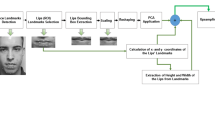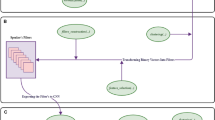Abstract
Learning representation from audio data has shown advantages over the handcrafted features such as mel-frequency cepstral coefficients (MFCCs) in many audio applications. In most of the representation learning approaches, the connectionist systems have been used to learn and extract latent features from the fixed length data. In this paper, we propose an approach to combine the learned features and the MFCC features for speaker recognition task, which can be applied to audio scripts of different lengths. In particular, we study the use of features from different levels of deep belief network for quantizing the audio data into vectors of audio word counts. These vectors represent the audio scripts of different lengths that make them easier to train a classifier. We show in the experiment that the audio word count vectors generated from mixture of DBN features at different layers give better performance than the MFCC features. We also can achieve further improvement by combining the audio word count vector and the MFCC features.




Similar content being viewed by others
Notes
A useful survey is presented by Kinnunen et al. [2] on the use of MFCCs and other features such as super vectors for speaker recognition.
Besides the work reviewed in this section, a more recent work has been reported lately in [3], which presents a deep neural network approach for speaker recognition task.
A useful tutorial on SVM is available from Burges [17].
The dataset can be requested via email.
References
Mohamed AR, Dahl GE, Hinton G (2012) Acoustic modeling using deep belief networks. IEEE Trans Audio Speech Lang Process 20(1):14–22
Kinnunen T, Li H (2010) An overview of text-independent speaker recognition: from features to supervectors. Speech Commun 52(1):12–40
Richardson F, Reynolds D, Dehak N (2015) Deep neural network approaches to speaker and language recognition. IEEE Signal Process Lett 22(10):1671–1675
Lee H, Pham P, Largman Y, Ng AY (2009) Unsupervised feature learning for audio classification using convolutional deep belief networks. In: Bengio Y, Schuurmans D, Lafferty J, Williams C, Culotta A (eds) Advances in neural information processing systems. NIPS, Abu Dhabi, pp 1096–1104
Garofolo J, Lamel L, Fisher W, Fiscus J, Pallett D, Dahlgren N, Zue V (1993) DARPA TIMIT acoustic phonetic continuous speech corpus cdrom. https://catalog.ldc.upenn.edu/LDC93S1
Senoussaoui M, Dehak N, Kenny P, Dehak R, Dumouchel P (2012) First attempt of Boltzmann machines for speaker verification. In: Odyssey 2012: the speaker and language recognition workshop. ACM, pp 1064–1071
Ghahabi O, Hernando J (2014) Deep belief networks for i-vector based speaker recognition. In: 2014 IEEE international conference on acoustics, speech and signal processing (ICASSP), pp 1700–1704
Dehak N, Kenny P, Dehak R, Dumouchel P, Ouellet P (2011) Front-end factor analysis for speaker verification. IEEE Trans Audio Speech Lang Process 19(4):788–798
NIST i-vector Machine Learning Challenge (2014). https://ivectorchallenge.nist.gov/
Ali H, d’Avila Garcez A, Tran S, Zhou X, Iqbal K (2014) Unimodal late fusion for NIST i-vector challenge on speaker detection. Electron Lett 50(15):1098–1100
Molau S, Pitz M, Schluter R, Ney H (2001) Computing mel-frequency cepstral coefficients on the power spectrum. In: Proceedings of 2001 IEEE international conference on acoustics, speech, and signal processing, vol 1, pp 73–76
Hinton GE, Salakhutdinov RR (2006) Reducing the dimensionality of data with neural networks. Science 313(5786):504–507
Le Roux N, Bengio Y (2008) Representational power of restricted Boltzmann machines and deep belief networks. Neural Comput 20(6):1631–1649
Deng L, Yu D (2014) Deep learning: methods and applications. NOW Publishers, Breda
Freund Y, Haussler D (1994) Unsupervised learning of distributions on binary vectors using two layer networks. University of California at Santa Cruz, Santa Cruz, Tech. Rep
Hinton GE (2002) Training products of experts by minimizing contrastive divergence. Neural Comput 14(8):1771–1800
Burges C (1998) A tutorial on support vector machines for pattern recognition. Data Min Knowl Discov 2(2):121–167
Chang CC, Lin CJ (2011) LIBSVM: a library for support vector machines. ACM Trans Intell Syst Technol, vol 2, pp 27:1–27:27. http://www.csie.ntu.edu.tw/~cjlin/libsvm
Ali H, Ahmad N, Yahya KM, Farooq O (2012) A medium vocabulary Urdu isolated words balanced corpus for automatic speech recognition. In: 2012 international conference on electronics computer technology (ICECT 2012), pp 473–476
Ali H, Ahmad N, Zhou X, Ali M, Manjotho A (2014) Linear discriminant analysis based approach for automatic speech recognition of Urdu isolated words. In: Communication technologies, information security and sustainable development, ser. communications in computer and information science, vol 414. Springer International Publishing, pp 24–34
Ali H, Ahmad N, Zhou X, Iqbal K, Ali SM (2014) DWT features performance analysis for automatic speech recognition of Urdu. SpringerPlus 3(1):204
Acknowledgments
The authors would like to thank Nasir Ahmad, University of Engineering and Technology Peshawar Pakistan and Tillman Weyde, City University London for their useful feedback during this work.
Hazrat Ali is grateful for funding from the Erasmus Mundus Strong Ties Grant. Emmanouil Benetos was supported by the UK AHRC-funded Project `Digital Music Lab-Analysing Big Music Data', Grant No. AH/L01016X/1 and is supported by a UK RAEng Research Fellowship, grant no. RF/128. Hazrat and Son have equal contribution to the paper.
Author information
Authors and Affiliations
Corresponding author
Rights and permissions
About this article
Cite this article
Ali, H., Tran, S.N., Benetos, E. et al. Speaker recognition with hybrid features from a deep belief network. Neural Comput & Applic 29, 13–19 (2018). https://doi.org/10.1007/s00521-016-2501-7
Received:
Accepted:
Published:
Issue Date:
DOI: https://doi.org/10.1007/s00521-016-2501-7




